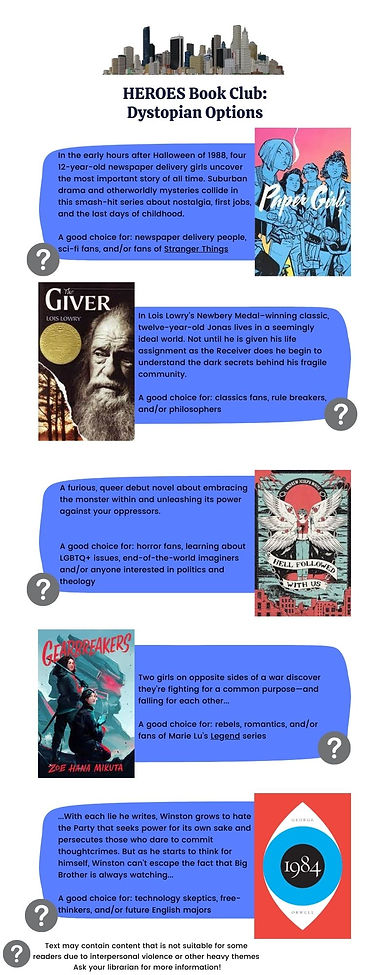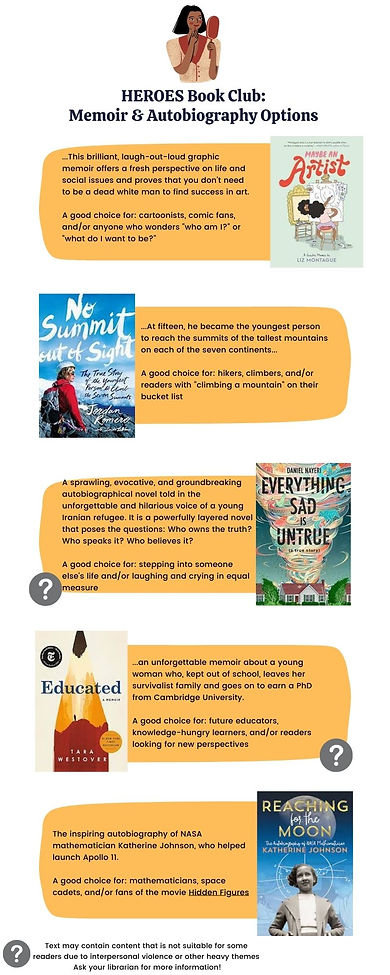Reading Ladder Book Clubs
Each list begins around a 500L/600L and ends upwards of 1000L, moving up in increments of approximately 100L with each rung. All ladders are filled with high-interest texts that have an interest level of approximately 16/18 years old. Some do skew younger, but did not appear to be markedly younger than other texts. This is because, as Cherry-Paul and Johansen warn in their text Breathing New Life into Book Clubs, "Our students can always sense if they're being grouped by ability, and this can cause anxiety and disappointment" (17).
Presenting high-interest texts which have a fairly smooth gradient between the "lower level" and "higher level" texts can ease some of this stress and allow students who are working on their proficiency the grace of being able to do so with less judgment. This provides a smoother experience for students who are reading up all rungs of the ladder, and the balance of age-appropriate themes throughout all rungs and genres allows students to engage with material that is still relevant and interesting to them.
While Lexile level is not the sole factor in determining text complexity, it was used in this ladder as a metric because it seemed to be the most objective way to evaluate a very subjective thing: difficulty. Many students consume similar news, social media posts, music, and movies and TV shows, and for that reason, emotional complexity was not heavily considered in the placement of a text higher or lower on the ladder (texts without significant warnings were included, of course, as it is not always realistic to expect high amounts of emotional labor from our students).
The overall theme of the ladders is "Heroes," and although it can be challenging to find 30+ books of a gradient of Lexiles and age-appropriate themes, this thematic continuity can help to foster a sense of community between the book clubs (Cherry-Paul and Johansen, 58). This theme may also tie in to other texts that are frequently used in curriculum, like Homer's The Odyssey or Shakespeare's Romeo and Juliet. Other high-interest themes that span multiple genres may be: love or first love, justice, coming-of-age, activism or social change, identity crisis, power, technology and society, etc.
Factors to consider:
-
Title
-
Is it interesting, mysterious, funny?
-
-
Cover
-
Does it look modern, interesting? Are the colors bold, muted? How about the art style and the font?
-
-
Form & Format
-
Is the format unusual? How many points of view are there, and do they change?
-
-
Genre
-
Which genres are "in" right now?
-
-
Movie and TV tie ins
-
Is there a movie or TV show adaptation of this book? Does it relate to recent pop culture trends?
-
-
Social media trends and BookTok
-
Does this title reflect recent lifestyle or fashion trends? Did it go viral on BookTok?
-
Below are some resources that I used to find and evaluate these texts, as well as resources that can be used to identify possible trigger and content warnings to keep all students safe, even as they are challenged with reading about higher-level issues:
EBSCO's Novelist: https://www.ebsco.com/novelist
YALSA Booklists:
W.N.D.B.'s Database:
The Stonewall Awards list:
https://www.ala.org/rt/rrt/award/stonewall/honored
Bookriot's articles:
School Library Journal:
Amazon:
https://www.amazon.com/
Trigger warning database:
.jpg)
.jpg)
.jpg)
.jpg)
.jpg)
.jpg)